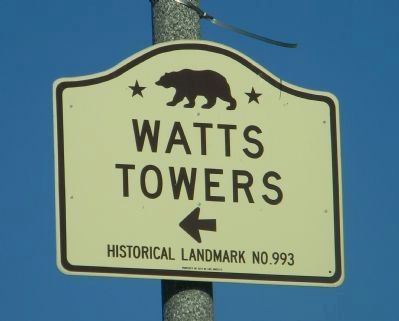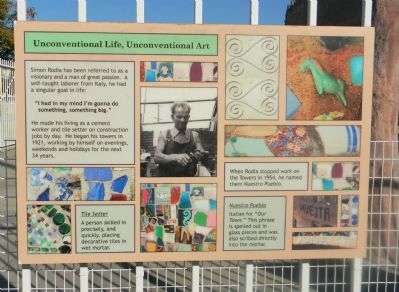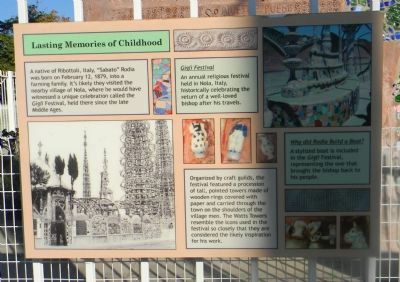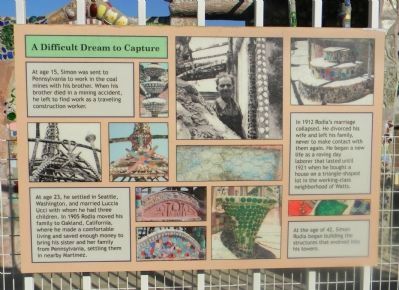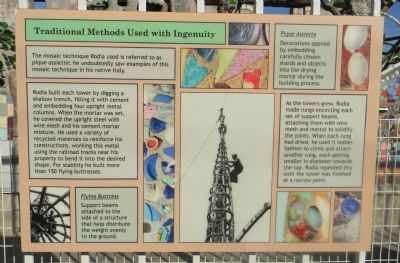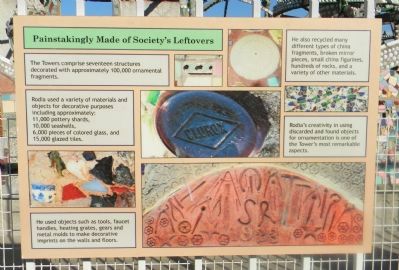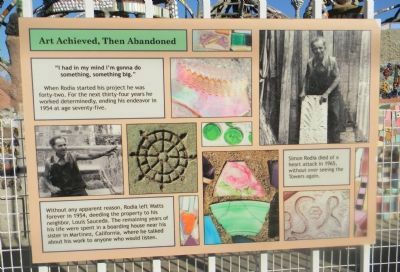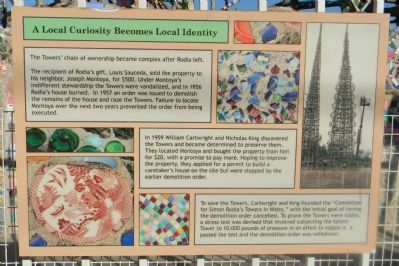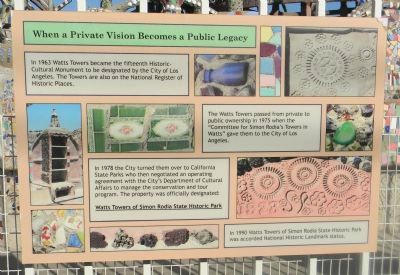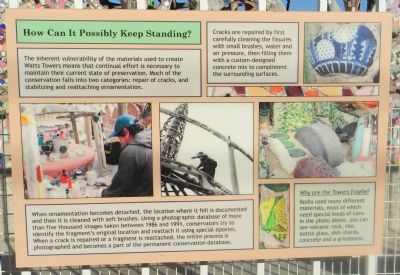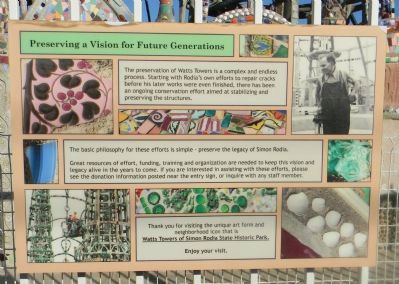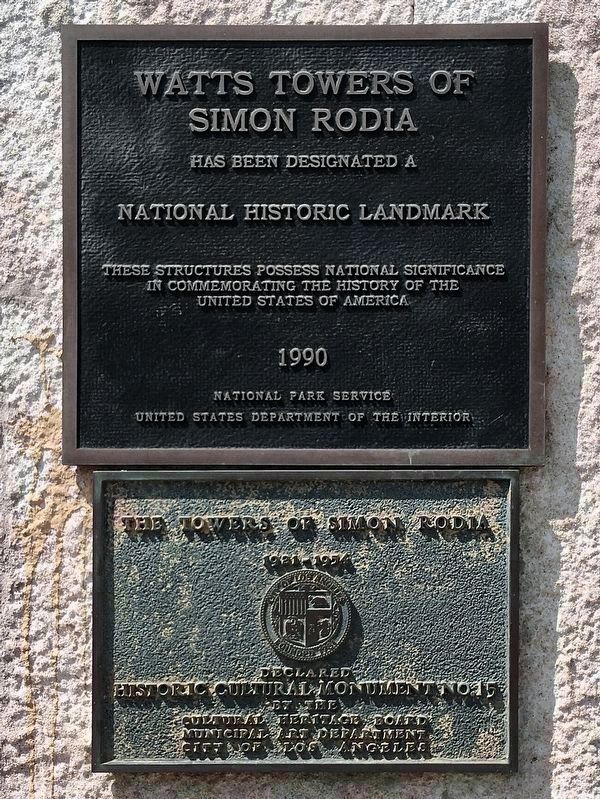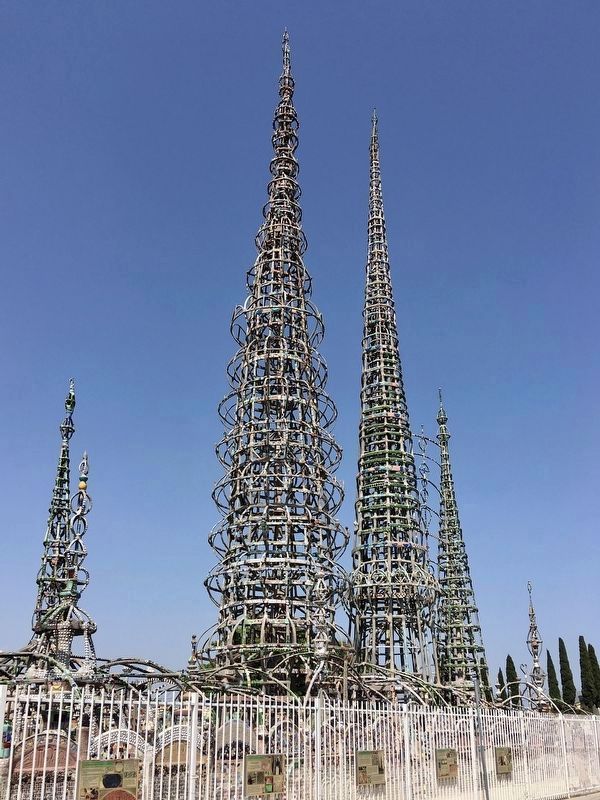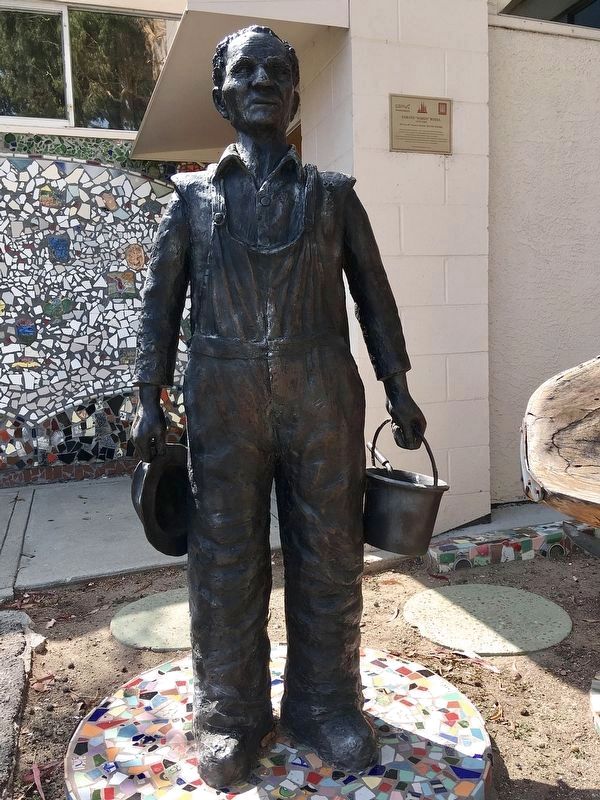South Los Angeles in Los Angeles County, California — The American West (Pacific Coastal)
Watts Towers
National Historic Landmark
— Watts Towers of Simon Rodia State Historic Park —
Panel 1:
California Historical Landmark No. 993
Panel 2:
Unconventional Life, Unconventional Art
Simon Rodia has been referred to as a visionary and a man of great passion. A self-taught laborer from Italy, he had a singular goal in life:
“I had in my mind I’m gonna do something, something big.”
He made his living as a cement worker and tile setter on construction jobs by day. He began his towers in 1921, working by himself on evenings, weekends and holidays for the next 34 years.
When Rodia stopped work on the Towers in 1954, he named them Nuestro Pueblo.
Tile Setter
A person skilled in precisely, and quickly, placing decorative tiles in wet mortar.
Nuestro Pueblo
Italian for “Our Town.” This phrase is spelled out in glass pieces and was also scribed directly into the mortar.
Panel 3:
Lasting Memories of Childhood
A native of Ribottoli, Italy, “Sabato” Rodia was born on February 12, 1879, into a farming family. It’s likely they visited the nearby village of Nola, where he would have witnessed a unique celebration called the Gigli Festival, held there since the late Middle Ages.
Gigli Festival
An annual religious festival held in Nola, Italy, historically celebrating the return of a well-loved bishop after his travels.
Organized by craft guilds, the festival featured a procession of tall, pointed towers made of wooden rings covered with paper and carried through the town on the shoulders of the village men. The Watts Towers resemble the icons used in the festival so closely that they are considered the likely inspiration for his work.
Why did Rodia Build a Boat?
A stylized boat is included in the Gigli Festival, representing the one that brought the bishop back to his people.
Panel 4:
A Difficult Dream to Capture
At age 15, Simon was sent to Pennsylvania to work in the coal mines with his brother. When his brother died in a mining accident, he left to find work as a traveling construction worker.
At age 23, he settled in Seattle, Washington, and married Luccia Ucci with whom he had three children. In 1905 Rodia moved his family to Oakland, California, where he made a comfortable living and saved enough money to bring his sister and her family from Pennsylvania, settling them in nearby Martinez.
In 1912 Rodia’s marriage collapsed. He divorced his wife and left his family, never to make contact with them again. He began a new life as a roving day laborer that lasted until 1921 when he bought a house on a triangle-shaped lot in the working–class neighborhood of Watts.
At the age of 42, Simon Rodia began building the structures that evolved into his towers.
Panel 5:
Traditional Methods Used with Ingenuity
The mosaic technique Rodia used is referred to as pique assiette; he undoubtedly saw examples of this mosaic technique in his native Italy.
Pique Assiette
Decorations applied by embedding carefully chosen shards and objects into the drying mortar during the building process.
Rodia built each tower by digging a shallow trench, filling it with cement and embedding four upright metal columns. When the mortar was set, he covered the upright steel with wire mesh and his cement mortar mixture. He used a variety of recycled materials to reinforce his constructions, working this metal using the railroad tracks near his property to bend to bend it into the desired shape. For stability he built more than 150 flying buttresses.
Flying Buttress
Support beams attached to the side of a structure that help distribute the weight evenly to the ground.
As the towers grew, Rodia made rungs encircling each set of support beams, attaching them with wire mesh and mortar to solidify the joints. When each rung had dried, he used it ladder-fashion to climb and attach another rung, each getting smaller in diameter towards the top. Rodia repeated this until the tower was finished at a narrow point.
Panel 6:
Painstakingly Made of Society’s Leftovers
The towers comprise seventeen structures decorated with approximately 100,000 ornamental fragments. Rodia used a variety of materials and objects for decorative purposes including approximately:
11,000 pottery shards,
10,000 seashells,
6,000 pieces of colored glass, and
15,000 glazed tiles.
He used objects such as tools, faucet handles, heating grates, gears and metal molds to make decorative imprints on the walls and floors.
He also recycled many different types of china fragments, broken mirror pieces, small china figurines, hundreds of rocks, and a variety of other materials.
Rodia’s creativity in using discarded and found objects for ornamentation is one of the Tower’s most remarkable aspects.
Panel 7:
Art Achieved, Then Abandoned
“I had in my mind I’m gonna do something, something big.”
When Rodia started his project he was forty-two. For the next thirty-four years he worked determinedly, ending his endeavor in 1954 at age seventy-five.
Without any apparent reason, Rodia left Watts forever in 1954, deeding the property to his neighbor, Louis Sauceda. The remaining years of his life were spent in a boarding house near his sister in Martinez, California, where he talked about his work to anyone who would listen.
Simon Rodia died of a heart attack in 1965, without ever seeing the Towers again.
Panel 8:
A Local Curiosity Becomes Local Identity
The Towers’ chain of ownership became complex after Rodia left.
The recipient of Rodia’s gift, Louis Sauceda, sold the property to his neighbor, Joseph Montoya, for $500. Under Montoya’s indifferent stewardship the Towers were vandalized, and in 1956 Rodia’s house burned. In 1957 an order was issued to demolish the remains of the house and raze the Towers. Failure to locate Montoya over the next two years prevented the order from being executed.
In 1959 William Cartwright and Nicholas King discovered the Towers and became determined to preserve them. They located Montoya and bought the property from him for $20, with a promise to pay more. Hoping to improve the property, they applied for a permit to build a caretaker’s house on the site but were stopped by the earlier demolition order.
To save the Towers, Cartwright and King founded the “Committee for Simon Rodia’s Towers in Watts,” with the initial goal of having the demolition order cancelled. To prove the Towers were stable, a stress test was devised that involved subjecting the tallest Tower to 10,000 pounds of pressure in an effort to topple it. It passed the test and the demolition order was withdrawn.
Panel 9:
When a Private Vision Becomes a Public Legacy
In 1963 Watts Towers became the fifteenth Historic Cultural Monument to be designated by the City of Los Angeles. The Towers are also on the National Register of Historic Places.
The Watts Towers passed from private to public ownership in 1975 when the “Committee for Simon Rodia’s Towers in Watts” gave them to the City of Los Angeles.
In 1978 the City turned them over to California State Parks who then negotiated an operating agreement with the City’s Department of Cultural Affairs to manage the conservation and tour program. The property was officially designated: Watts Towers of Simon Rodia State Historic Park.
In 1990 Watts Towers of Simon Rodia State Historic Park was accorded National Historic Landmark status.
Panel 10:
How Can It Possibly Keep Standing?
The inherent vulnerability of the materials used to create Watts Towers means that continual effort is necessary to maintain their current state of preservation. Much of the conservation falls into two categories; repair cracks, and stabilizing and reattaching ornamentation.
Cracks are repaired by first carefully cleaning the fissures with small brushes, water and air pressure, then filling them with a custom-designed concrete mix to compliment the surrounding surfaces.
When ornamentation becomes detached, the location where it fell is documented and then it is cleaned with soft brushes. Using a photographic database of more than five thousand images taken between 1986 and 1991, conservators try to identify the fragment’s original location and reattach it using special epoxies. When a crack is repaired or a fragment is reattached, the entire process is photographed and becomes a part of the permanent conservation database.
Why are the Towers Fragile?
Rodia used many different materials, most of which need special kinds of care. In the photo above, you can see volcanic rock, tile, bottle glass, dish shards, concrete and a grindstone.
Panel 11:
Preserving a Vision for Future Generations
The preservation of Watts Towers is a complex and endless process. Starting with Rodia’s own efforts to repair cracks before his later works were even finished, there has been an ongoing conservation effort aimed at stabilizing and preserving the structures.
The basic philosophy for these efforts is simple – preserve the legacy of Simon Rodia.
Great resources of effort, funding, training and organization are needed to keep this vision and legacy alive in the years to come. If you are interested in assisting with these efforts, please see the donation information posted near the entry sign, or inquire with any staff member.
Thank you for visiting the unique art form and neighborhood icon that is Watts Towers of Simon Rodia State Historic Park. Enjoy your visit.
Erected by Watts Towers of Simon Rodia State Historic Park. (Marker Number 993.)
Topics and series. This historical marker is listed in these topic lists: Arts, Letters, Music • Parks & Recreational Areas. In addition, it is included in the California Historical Landmarks, the Los Angeles Historic-Cultural Monument, and the National Historic Landmarks series lists. A significant historical year for this entry is 1921.
Location. 33° 56.324′ N, 118° 14.466′ W. Marker is in Los Angeles, California, in Los Angeles County. It is in South Los Angeles. Marker is on 107th Street east of Graham Avenue, on the left when traveling east. Touch for map. Marker is at or near this postal address: 1765 E 107th St, Los Angeles CA 90002, United States of America. Touch for directions.
Other nearby markers. At least 8 other markers are within 5 miles of this marker, measured as the crow flies. Maya Obelisk (about 600 feet away, measured in a direct line); Egyptian Obelisk (approx. 0.3 miles away); Eagle Tree (approx. 2.7 miles away); Heritage House (approx. 3.3 miles away); PFC James Anderson (approx. 4 miles away); Rosecrans Playground (approx. 4.1 miles away); Leon “Ted” Garr Square (approx. 4.2 miles away); Chester Washington Golf Course (approx. 4.3 miles away). Touch for a list and map of all markers in Los Angeles.
Also see . . .
1. The Watts Towers of Sam Rodia. Film: The Towers - 1957 (Submitted on January 25, 2012, by Richard E. Miller of Oxon Hill, Maryland.)
2. Watts Towers of Simon Rodia Wikipedia. (Submitted on January 25, 2012, by Richard E. Miller of Oxon Hill, Maryland.)
3. Watts, Los Angeles, Wikipedia. (Submitted on January 25, 2012, by Richard E. Miller of Oxon Hill, Maryland.)
Additional keywords. Watts Towers Arts Center
Credits. This page was last revised on January 23, 2024. It was originally submitted on January 24, 2012, by Richard E. Miller of Oxon Hill, Maryland. This page has been viewed 1,954 times since then and 62 times this year. It was the Marker of the Week December 18, 2016. Photos: 1, 2, 3, 4, 5. submitted on January 24, 2012, by Richard E. Miller of Oxon Hill, Maryland. 6, 7, 8, 9, 10, 11. submitted on January 25, 2012, by Richard E. Miller of Oxon Hill, Maryland. 12, 13, 14. submitted on April 28, 2022, by Craig Baker of Sylmar, California. • Syd Whittle was the editor who published this page.
